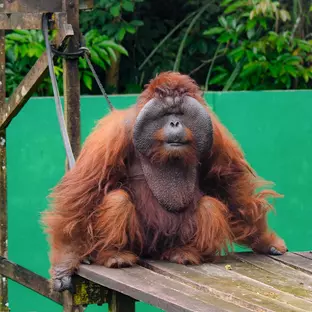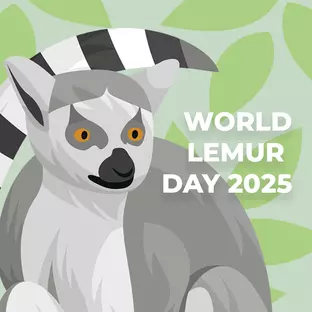You might have noticed a small theme running through our last couple of blogs...that's because we are, of course, dedicating December to monkeys! Okay, so while we might not write about our tree-dwelling chums every single day, we are lending our focus to them for a good amount of time, since later this month we will be celebrating Monkey Day. Before that, though, we think it might be fun to learn a little about the stars themselves! Allow us to present our top fascinating monkey facts.
Staring with a bit of background: there are currently 264 known species of monkey, split into two categories: Old World, and New World. One of the main ways to spot the difference between these two sub-categories is by getting a glimpse of their gnashers - the former have 32 teeth, whereas the latter have slightly more at 36.
Delving deeper into monkey history here...: while we can't pinpoint exactly when monkeys made it to this earth, we do know that the first primates appeared around 50-55 million years ago. Impressive, until you consider that the earth is about 4.54 billion years old, and the first known life dates back at last 3.5 billion years ago. In fact, most other animal species flourish and became extinct before the first monkeys were around - kind of crazy to think that there was, essentially, a whole other world before the one we know, right?
Looking a little closer at what we do know about monkeys, you'd be forgiven for wondering where they got their name from. Well, this is actually a bit of a grey area, but some believe that it is derived from the word 'manneken', meaning 'little man.' How adorable is that!

Before we speak more specifically about particular species of monkeys, first it might be best to make clear the distinct difference between these guys and their other primate pals. Some people use the word 'ape' interchangeably with 'monkey', but other than being a bit of a lapse in terminology, it must be noted that monkeys and apes are not the same. They actually belong to very different families in the umbrella category of 'primate', but to make things very simple when trying to spot the difference: just keep your eyes open for a tail! Just about every species of monkey has one (with the exception of the Barbary macaque - sometimes referred to as the 'Barbary ape', which makes things all the more confusing!); conversely, no single species of ape has a tail. Oh, and while we mention apes...did you know that humans are classed as apes, too!? See, no tail!!!
Now, back to the monkeys themselves...let's talk about the differences between each species. Monkeys do have very varied habitats, hailing from all around the world - Africa, Asia and South America, to be exact. But did you know that there are monkeys in Europe, too?! Previously, we mentioned a type of monkey called the Barbary Macaque. What's fascinating about this species of monkey is that it's the only free-living simian in all of Europe. Originally endemic to North Africa, the Barbary Macaque made its way over to the British territory of Gibraltar, and now lives in relative harmony with the human beings (or, human apes...) that live there, too. Interestingly, this is the only area of the world where their populations continue to grow, with 300 of them living on the land - that's around 1% of Gibraltar's whole population!
To speak for a second of a more exotic monkey, let's turn our attention to Indonesia's own Proboscis monkey. Famous for its large nose, the Proboscis is one of the most unusual looking monkeys out there...but did you know that that huge hooter is a feature only the males have? On the contrary, female Proboscis monkeys have much smaller, pointier noses, giving them much more of an elvish look. With regards to the males in this species, though, they're not born with such sizable snozzes; rather, their noses grow with age. It has also been said that a male Proboscis can attribute his loud bellow to its snout - apparently, the size of the thing enables the sound emitting from the monkeys to resonate at higher decibels!

Of all the different species of monkey, it has been said that the capuchin may just be the best at handy-work. Observed as being skilled with tools, they are able to smash nuts with rocks, insert branches into crevices to capture their food, and are even smart enough to protect their hands by coating them in leaves. In addition to this, they've also been seen to use large branches to kill snakes - surprising, when you consider how small and sweet looking these little guys are! In addition to their impressive use of tools, the capuchin are also really quite intelligent and are able to identify predators by using different vocal sounds. To alert other members of their troop about incoming danger, the capuchin will smash rocks together as a kind of 'danger' alarm.
Ready for another (somewhat gruesome) fact? Ever hear the one about the male squirrel monkey? Well, in case you haven't, here goes: did you know that to assert dominance, male squirrel monkeys will urinate on their subordinates?! After that grim bit of information, how about we chase it up with something a little cuter: adorably, the South American Titi monkeys are unique for their monogamy. They mate for life and become noticeably distressed when separated. When they’re together, they show affection by grooming each other, intertwining their tails and holding hands (!!!), as well as nuzzling, cuddling and lip smacking. How romantic! It's made me feel a little better about our furry friends, anyway...
Last but not least: if I were to become a monkey, I know which one I'd rather be. While they might not be the most beautiful, the Howler monkey are definitely one of the laziest (we already have so much in common!), and spend up to 80% of their time resting. These leisurely creatures are the largest of all the New World monkey, measuring between 2 and 4 feet fall and weighing up to a comfortable 22 pounds...you know, they're sounding more and more like me by the minute (I'm kidding. Mostly.) I'm all about a monkey that knows how to take it easy, and this is why the Japanese macaque is my very favourite of all - despite living in the most northern point of any primate on earth (apart from the human being, perhaps) and battling freezing cold tempteratures every day, the aptly nicknamed 'snow monkey' loves to chill out in Japanese hot springs, otherwise known as 'onsen.' Who else is starting to wish that we had more and more in common with these little guys?!

As envied a lifestyle the howler monkey has, or how jealous we may be of the snow monkey soaking in hot springs all day long, all of this pales in comparison to the hardships monkeys face on a day to day basis. Habitat loss, hunting, illegal pet trade and numerous other threats mean that a large amount of monkey species are currently at risk, and this is why Monkey Day is such an important occasion. On the 14th of December every year, people around the world strive to raise awareness of the issues monkeys face, all the while trying to keep a lighthearted and fun feel to the occasion. There's more about that coming up in the next week or so, but for now, why not take the facts that you've learnt today and share your simian knowledge with your friends? Better yet, take a look at our monkey conservation projects and get involved!
















